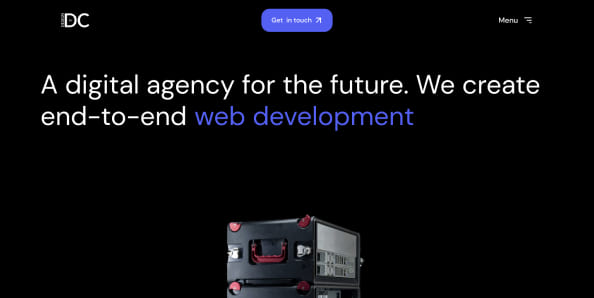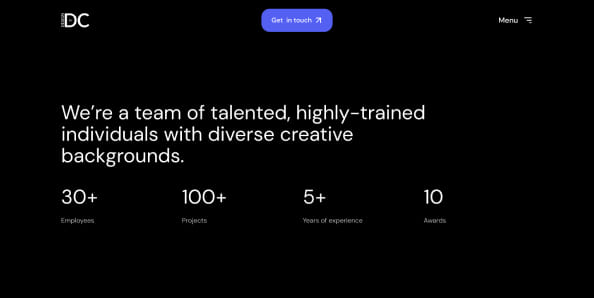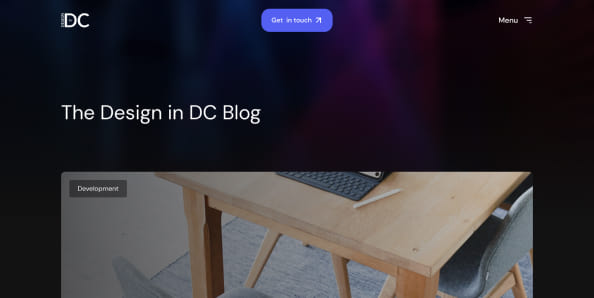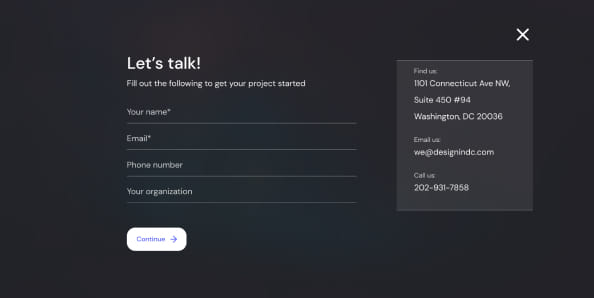A Step-by-Step Guide to Designing a Website
Too busy? We broke it down into 8 steps for you.
In today’s digital age, websites are everywhere. From Personal portfolios, e-commerce shops, and social media platforms, to AR realms and live concert simulations, websites are the perfect way to add tangibility to any idea you can conjure.
At Design in DC, we live breath and sleep websites-you should see our slack channel- so why wait? We created 8 steps that you can follow to build your website today.
1. Why do you want a website?
Having a website is like owning a piece of online real estate. It’s a space uniquely yours where your voice, brand, or services can shine. But before diving into the world of web development, it’s crucial to ask yourself, “Why do I want a website?” The answer to this question is the cornerstone upon which your site will be built, influencing its design, functionality, and content.
Every successful website begins with a clear goal and an understanding of its target audience. Are you looking to showcase your portfolio, sell products, or perhaps share your insights through a blog? Each purpose demands a unique approach. For instance, a portfolio website focuses on displaying your work and facilitating easy contact, while an eCommerce site prioritizes product listings and optimized payment gateways. Whatever your reason is, you want to make sure that It is clearly defined and communicated to your target audience.
2. Put a name on it! Get a domain
Selecting a domain name is a critical step in establishing your online presence. If your website is the house, think of your domain as the digital street address, guiding users directly to your site.
Criteria for an Effective Domain Name
You want to be very intentional with your domain name. When brainstorming domain names, consider
- Memorability: Your domain should be easy to remember. Avoid overly complex or lengthy names that could lead to typing errors.
- Simplicity: Steer clear of symbols, special characters, and numbers that might confuse users.
- Relevance: Choose a name that resonates with your brand or business. Incorporating keywords related to your industry can also aid in search engine optimization (SEO).
- Professionalism: A domain name that includes your business name enhances credibility and brand recognition.
Choosing the Right Extension
Extensions, also known as top-level domains (TLDs), follow your domain name and can significantly impact your website’s perception. Common extensions like .com, .org, and .net are universally recognized, but there are also more specific extensions like .store, .info, or .tv that might better align with your brand’s identity or industry. Before finalizing your choice, check the availability of your preferred domain name using domain registration tools. If your first choice is taken, experiment with variations or consider using a different extension. Once you’ve settled on a name, register it with a domain registrar and move on to step 3.
3. Choose your website builder
So now you have an address, but where is your house going to be? Choosing the right hosting platform is a pivotal decision in your website creation journey. It lays the foundation for your website’s performance, security, and scalability. With numerous hosting platforms available, here are 3 things to consider:
- Ease of Use: Simplifying Web Development
Consider platforms that offer user-friendly website builders. These tools allow you to set up, design, and manage your website without extensive technical knowledge. Squarespace and Wix are two popular platforms that we recommend.
- Customization Capabilities
Your website should reflect your unique brand and vision. Opt for hosting platforms that offer extensive customizability. Whether you’re building a static or dynamic website, the platform should provide the tools to tailor your site’s look and functionality.
- Quality of Support
Customer support can make a significant difference, especially in urgent situations. Look for platforms that offer comprehensive support channels, including round-the-clock assistance, knowledge bases and how-to guides.
Ultimately, it is important to choose a hosting platform that not only meets your current needs but also supports your website’s growth and evolution.
4. Define your brand identity and choose a layout that matches it
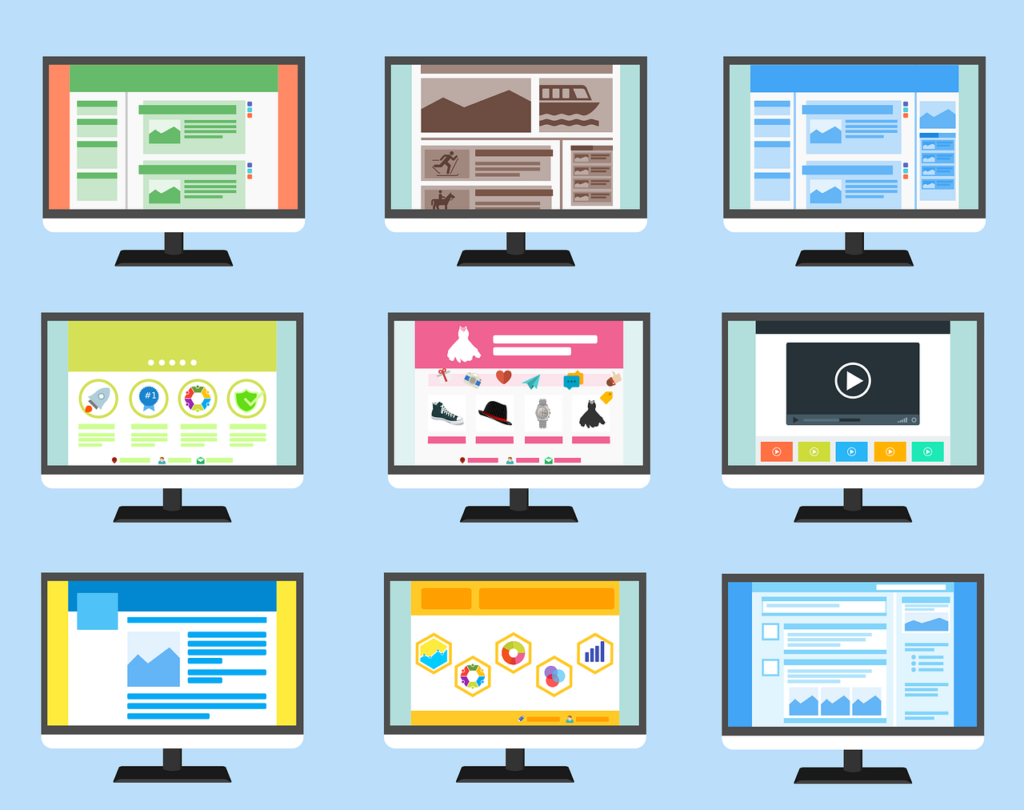
As the first point of contact between you and your audience, it is imperative that your website accurately reflects the essence of your brand. Whether it’s a minimalist approach for a modern brand or a more dynamic layout for a creative business, you want to establish a strong brand identity and choose a website layout that resonates with it. Here’s how
- Establishing Your Brand Identity- What does your brand stand for? This involves creating a brand identity guide that encompasses your mission, vision, values, and the emotions you wish to evoke.
- Choosing Colors That Speak Your Brand’s Language –Colors play a pivotal role in conveying your brand’s message and evoking specific emotions. It’s important to choose a color palette that aligns with your brand’s personality and message.
- Picking the Right Typography- Typography is another crucial element that shapes how your audience perceives your brand. Make sure your chosen typography is legible on both desktop and mobile devices.Traditionally, there are 3 styles of typography
- Serif: Fonts with a small line (serif) attached to the ends of each letter.
- Sans serif: More standard font without the serifs at the ends of each character. Better for legibility
- Script: Font that appears handwritten or cursive
- Incorporating Other Branding Elements
- Logo: Your logo should be prominently placed on your website and be consistent in style with your overall branding.
- Favicon: A favicon is the small image visible in the browser tab when someone visits your site.
- Imagery and Icons: Use images and icons that resonate with your brand’s voice and message. They should complement your color scheme and typography, creating a harmonious visual narrative. Specifically, if your site is optimized for e-commerce it is important to use custom high quality photography.
5. Structure your site for success
Once you have clearly defined how your website will look and the message you want it to communicate, It’s time to build! There are a few things that you want to make sure your website includes. Here are 5 key elements you should include.
- User-Friendly Navigation Menu
Your website’s menu is like a roadmap guiding visitors through your site. It should be intuitive and accessible on every page. Limit the number of items in your menu to avoid overwhelming your visitors and ensure that it reflects your brand’s priorities and style. Consider whether a horizontal or vertical layout aligns better with your brand and the user experience you want to create.
- Designing a Header and Footer that Speak Volumes
The header and footer are more than just bookends to your web pages; they are critical components of your brand’s narrative. Your header should prominently feature elements like your navigation menu and logo, making them instantly accessible. The footer, often an underutilized space, is an opportunity to provide additional information and links, reinforcing your brand identity and aiding navigation.
- Incorporating a Search Bar for Enhanced Accessibility
A well-placed search bar, typically in the top-left or top-right corner, is essential for a user-friendly experience. It allows visitors to quickly find what they’re looking for, which is particularly beneficial for content-rich websites.
- Creating an Effective Sitemap
Your sitemap is the structural blueprint of your site. It should be thoughtfully organized to ensure that search engines and visitors can easily navigate and understand your content. Regular updates to your sitemap are necessary to reflect any changes in your site’s structure.
- Optimizing for Mobile Navigation
With the increasing use of mobile devices, optimizing your site for mobile navigation is crucial. Your mobile menu should offer a clear and straightforward navigation experience, ensuring that all elements translate well to smaller screens.
6. Include Relevant Pages
Ok, so you are confident with the structure of your website. Now what?
Like a well-organized book, each page of your website serves a purpose that contributes to the overall narrative. While the specific pages you include depends on your unique business needs, here are 9 standard pages that are essential to a successful website
- Home Page: Your Digital Welcome Mat
Your homepage sets the tone for your entire website. It’s crucial that this page is clean, organized, and visually appealing. It should quickly convey who you are, what you offer, and guide visitors to explore further. Essential elements include your logo, business name, and a clear navigation menu. This is your chance to make a strong first impression.
- About Us Page: Telling Your Story
The About Us page is where you connect with your visitors on a more personal level. Share your story, values, and the unique aspects of your brand. This is your chance to build trust with your audience so use a friendly and approachable tone, along with photos of yourself or your team.
- Contact Page: Facilitating Easy Communication
Ensure that visitors can easily contact you through a dedicated Contact page. Include various contact options like phone numbers, email addresses, and links to social media profiles. Consider adding a live chat feature or a contact form for immediate inquiries or messages.
- Product or Service Page: Showcasing What You Offer
If your website involves selling products or services, this page is vital. Highlight your offerings with high-quality images and engaging descriptions. Be transparent about conditions like shipping or return policies. This page is your opportunity to turn visitors into customers.
- Blog: Establishing Your Expertise
A blog is an excellent tool for demonstrating expertise, engaging with your community, and enhancing SEO. Share your insights, stories, and tips relevant to your industry. Remember, the quality of content is more important than quantity, so focus on providing valuable, unique insights.
- Testimonials and Reviews: Leveraging Social Proof
Whether you are a business or a freelance professional, incorporating a testimonials page can significantly boost your credibility. Showcase positive reviews and experiences from past customers to provide social proof and reassure potential customers of your reliability and quality.
- FAQ Page: Answering Common Questions
An FAQ page is a helpful resource for your visitors, saving them time and providing instant answers to common questions. It’s also a great tool for reducing repetitive inquiries, allowing you to focus on other aspects of your business.
- Privacy Policy Page: Building Trust Through Transparency
A privacy policy page is often required for legal compliance, especially if you’re collecting user data or using third-party services.
- Custom 404 Page: Handling Errors with Grace
A custom 404 page helps maintain a good user experience even when visitors encounter a broken link. Maybe you make it funny, or keep it simple, but make sure to provide links back to your homepage or main sections.
7. Publish and Promote
Once you have the necessary pages, we recommend that you get others to review on your site. A new pair of eyes can add new perspectives to colors and catch those sneaky typos. After the feedback and you feel confident with your site, it’s time to publish. Our work here is done right? Wrong! Most people stop after they publish and never make a plan to strategically promote their site.
Digital Marketing is huge, and most people never tap into its full potential, but don’t worry, we got you covered. Here are 4 strategies we recommend you use to promote your site.
- Leverage Social Media Platforms
Social media is a powerful tool for website promotion. Identify where your target audience is most active and tailor your content to these platforms. Each platform has its unique dynamics; for example, transforming Instagram posts into Reels can capture more attention. Engaging posts that link back to your website can significantly boost your online presence.
- Dive into the World of SEO
Search Engine Optimization (SEO) is essential for improving your website’s visibility on search engines like Google. While SEO can seem technical, many website builders offer tools to simplify this process. Remember, SEO is a long-term strategy and may take time to show results.
- Utilize Email Marketing
Email marketing remains an effective way to connect with your audience. Tools that allow you to create and send professional emails can drive significant traffic to your site. Use email marketing for sending newsletters, promoting products, or sharing updates. This helps in building a loyal customer base and keeping your audience engaged with your content.
- Create Compelling Blog Content
As we said in step 6, blogging is more than just writing articles; it’s a strategic, and often overlooked approach to content marketing. Writing SEO-rich, engaging blog posts can captivate your audience and improve your search engine rankings.
- Invest in Advertising
For immediate results, consider paid advertising. Platforms like Google Ads and Facebook Ads can be effective in driving traffic to your site. It’s important to focus your efforts and budget on the most effective channels for your audience.
8. Maintain your website to ensure long-term success

Boom! And just like that, your website is public. Congratulations, take a moment to celebrate, but know the work here is not done.The launch of your website marks the beginning of an ongoing process of maintenance and improvement. A website is not a set-and-forget element of your business; it requires regular attention, updates and sometimes full re-designs to stay relevant and effective.
Regularly Update Your Website- Regularly review and update your website to improve navigation, enhance user experience, and ensure that your content remains relevant and engaging.
Monitor Website Traffic and User Behavior- Utilize website analytics to gain insights into how visitors interact with your site. Tools that track user behavior can help you understand which pages are performing well and where improvements are needed.
Stay Informed and Evolve- Keep in touch of the latest trends in web design and user experience (UX). The digital landscape is constantly evolving, and your website should too.
Refresh Content Regularly- Your website’s content should be current. Regular content updates, such as blog posts or news updates, show your visitors that you and your website are active and engaged in your field.
Final thing to keep in mind
Remember building a website is a fun and creative project that can take you and your business to the next level. But it is important to make sure you include the necessary elements that fully capture your target audience. A website is the first impression of you and/or your business so make sure you are putting your best foot forward in the eyes of your potential customers.
